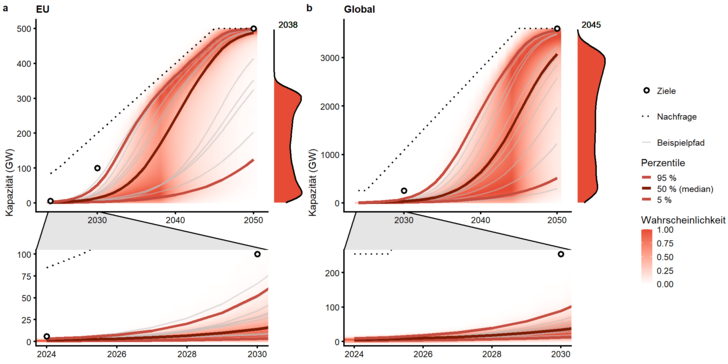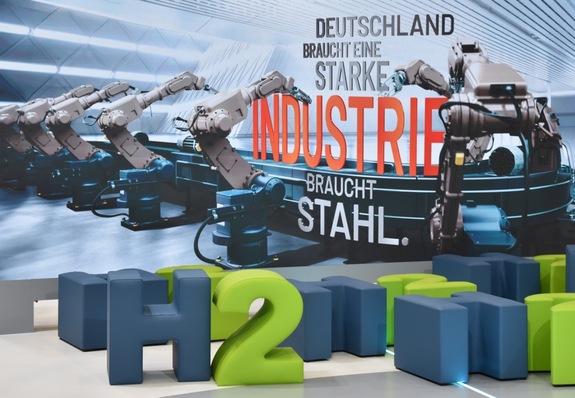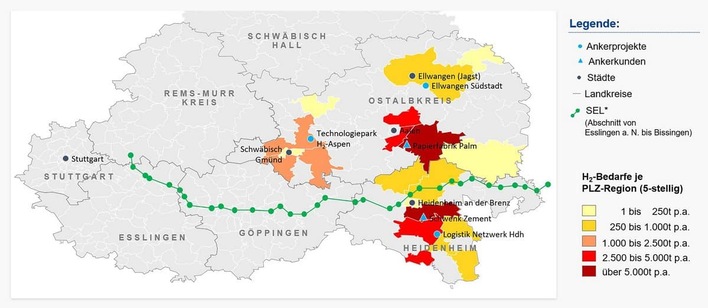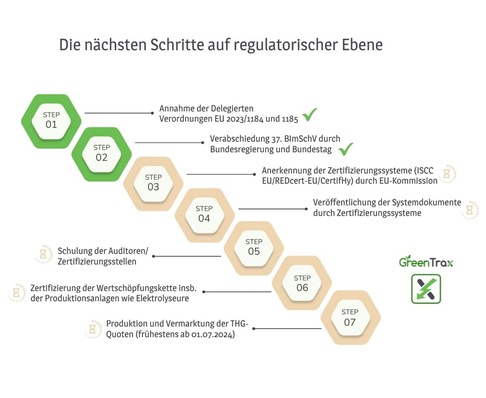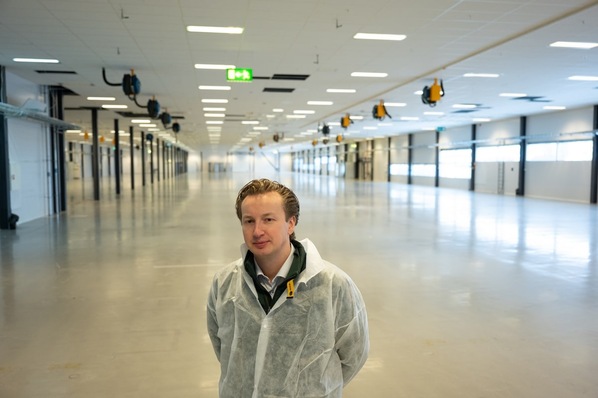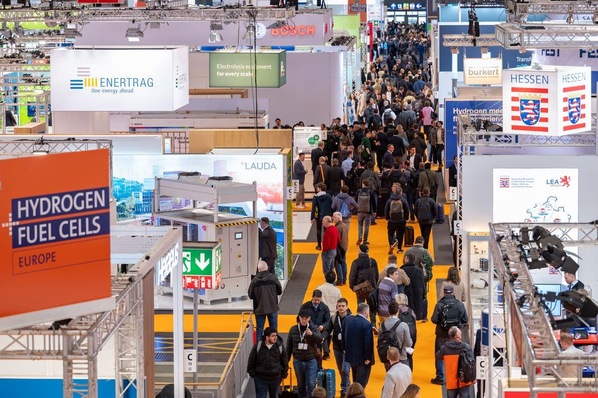The market ramp-up of electrolysis is a significant constraining factor for the mass production of green hydrogen. In an article that appeared recently in Nature Energy we analyzed possible pathways for expanding electrolyzer capacity in the European Union and around the world (Odenweller et al., 2022). Using a technology diffusion model we showed that the market ramp-up needs time in spite of initial exponential growth. Even if electrolysis expands as rapidly as photovoltaics and wind energy – the reigning growth champions – there will still be a short-term lack of green hydrogen and its availability in the long run remains uncertain. Nevertheless, it is important to accelerate the ramp-up now in order to ensure ambitious 2030 expansion targets can be reached and to guarantee long-term availability.
Because electrolysis is a key technology for the production of green hydrogen, the market ramp-up of electrolyzer capacity represents a critical area of constraint (IRENA, 2020). The magnitude of the scaling required is enormous, since at the end of 2021 only around 600 megawatts of electrolyzer capacity were in operation worldwide. To meet the 3,670-gigawatt figure in 2050 that the International Energy Agency (IEA) says is needed to achieve net-zero, capacity must be increased 6,000-fold (IEA, 2022b), thereby dwarfing the tenfold expansion in renewable energy capacity that will likewise be required.
Furthermore, electrolysis expansion poses a coordination challenge in terms of ensuring that not just the hydrogen supply but also the demand and infrastructure for hydrogen are driven up simultaneously. This is the proverbial “three-sided chicken-and-egg problem” of ramping up the hydrogen market (Schulte et al., 2021).
In the following we summarize the key results of our recently published article on scaling up electrolysis (Odenweller et al., 2022). Our synopsis shows updated figures and results based on the most recent version of the IEA Hydrogen Projects Database as of October 2022 (IEA, 2022a).
Announced electrolyzer projects
The years ahead are due to see a pronounced upswing in project announcements (see fig. 1). If all the projects announced come to fruition, electrolyzer capacity in the European Union will increase by a factor of 28 by the year 2024 compared with the year 2021; globally it will grow by a factor of 23. However, this positive outlook comes with the caveat that final investment decisions have yet to be made for over 80 percent of these project announcements. Consequently there is a large degree of uncertainty about how many projects will be realized in the short term and therefore whether sufficient green hydrogen will be made available in time to reach net-zero.
We therefore asked the following question in the main scenario outlined in our article: “What would happen if electrolysis expands as quickly as photovoltaics or wind energy in its boom phase?” To cover unavoidable uncertainties we used a model to simulate and then aggregate the technology diffusion of electrolyzers in response to thousands of different parameter constellations (see box).
In the event that electrolyzer capacity expands just as rapidly as photovoltaics and wind energy once did – the two greatest success stories for the energy transition thus far – the primary outcome can be encapsulated as follows: short-term scarcity, long-term uncertainty.
Methodology: technology diffusion model
New technologies usually penetrate markets in the form of an S-curve. In this situation, there is an initial period of exponential growth which is followed by a virtually linear increase in the growth phase before growth diminishes in the saturation phase and approaches the peak. In our article we extended this standard model of technology diffusion by deploying a stochastic uncertainty analysis. We considered uncertain parameters to be (i) the electrolyzer capacity in the near future, specifically in the year 2024, (ii) the initial exponential growth rate and (iii) the demand for green hydrogen, for which we assumed a continuous increase based on policy targets and net-zero scenarios. The combined propagation of these independent uncertainties finally resulted in what we called the “probabilistic area of possibility”.
Short-term scarcity
Even if similar growth rates are experienced to photovoltaics and wind energy, it still remains the case that electrolyzer capacity and therefore also the supply of green hydrogen will be insufficient for one or two decades. This applies both in comparison with the short-term and medium-term expansion targets and in comparison with the size of the overall energy system. In particular, the EU’s aim of producing 10 million metric tons a year of renewable hydrogen by 2030, which requires approximately 100 gigawatts of electrolyzer capacity, is not achievable with these growth rates. The same applies to the 720 gigawatts of global electrolyzer capacity that the IEA says are required by 2030 in its ambitious Net Zero Emissions scenario (IEA, 2022b).
In relation to the energy system as a whole this means that, even if electrolysis expands at the same speed as photovoltaics and wind energy, it will probably only be possible for green hydrogen to cover less than 1 percent of respective final energy demand in the EU by 2030 and worldwide by 2035.
Long-term uncertainty
The long-term view shows that a breakthrough to large-scale electrolyzer capacities is possible and becomes ever more likely. However, the timing and the size of this breakthrough are subject to considerable uncertainties.
In the event of similar growth rates to that of photovoltaics and wind energy, the breakthrough in the EU on average occurs by the year 2038 and globally by the year 2045. Given the great excitement surrounding the subject of hydrogen at the moment, that may be cause for surprise. Of course, when starting from a very small baseline, it takes a long time for high relative growth rates to also translate into high absolute capacities.
Growth under emergency measures
Our article describes an unbiased IF-THEN analysis based on the key assumption that electrolyzer capacity mirrors the speed of expansion in photovoltaics and wind energy. In the annex to the article, we presented a list of arguments for and against the issue of whether electrolysis could grow more rapidly than these successful technologies.
To investigate what might be possible under particular circumstances, we also asked the following question: “What would happen if electrolysis expands as quickly as technologies with the highest historical growth rates?” To answer this we looked at the growth rates of an extremely heterogeneous dataset, ranging from US military production and the expansion of the Chinese high-speed rail network to the market diffusion of web hosting and smartphones. The analysis shows that it is only by assuming these unusually high growth rates that the EU’s 2030 hydrogen target remains within reach and that the gap between possible supply and potential demand for hydrogen can be closed.
Political implications
It will only be possible to achieve these kinds of high growth rates with special political coordination, regulation and financing. Appropriate policy measures will need to safeguard the viability of private hydrogen investments, for example through public co-financing or direct regulation, e.g., via green hydrogen quotas. Furthermore, the ability to ramp up supply, demand and infrastructure simultaneously will require considerable coordination.
Thanks to the European Commission’s IPCEI hydrogen projects, the planned EU Hydrogen Bank and the US Inflation Reduction Act, the world’s two largest economies have recently given fresh impetus to the promotion of hydrogen. Nevertheless, it is still to be seen whether these measures are sufficient to break the vicious circle of uncertain supply, insufficient demand and incomplete infrastructure.
As long as the availability and the costs of green hydrogen remain uncertain, political decision-makers should be made aware of the risk of overestimating the potential of hydrogen. If future hydrogen supply exceeds expectations, it will not be problematical to find applications for it. By contrast if hydrogen supply lags behind expectations, however, it will then be too late for many applications to switch to alternatives in time to reach net-zero.
It continues to be a political balancing act: On the one hand, the speed of scale-up for green hydrogen needs to be increased considerably. On the other hand, the associated expectation of green hydrogen expansion should not slow down the necessary ramp-up in existing and more efficient alternatives of direct electrification, such as heat pumps and electric cars.
This study by the Potsdam Institute for Climate Impact Research was presented in February 2022 at the H2-Kompass conference in Berlin and was also reported upon in H2-international, May 2022. As the findings led to exaggerated headlines in the media in some instances, the key elements have been outlined again here in a little more detail.
Reference(s)
IEA. (2022a). Hydrogen Projects Database. https://www.iea.org/data-and-statistics/data-product/hydrogen-projects-database
IEA. (2022b). World Energy Outlook 2022. https://www.iea.org/reports/world-energy-outlook-2022
IRENA. (2020). Green hydrogen cost reduction: Scaling up electrolysers to meet the 1.5°C climate goal. International Renewable Energy Agency. https://www.irena.org/publications/2020/Dec/Green-hydrogen-cost-reduction
Odenweller, A., Ueckerdt, F., Nemet, G. F., Jensterle, M., & Luderer, G. (2022). Probabilistic feasibility space of scaling up green hydrogen supply. Nature Energy, 7(9), Art. 9. https://doi.org/10.1038/s41560-022-01097-4
Schulte, S., Sprenger, T., & Schlund, D. (2021). Perspektiven auf den Wasserstoffmarkthochlauf: Stakeholderanalyse mit Fokus Deutschland (EWI Policy Brief).
Authors:
Adrian Odenweller
adrian.odenweller@pik-potsdam.de
Dr. Falko Ueckerdt
falko.ueckerdt@pik-potsdam.de
Both from the Potsdam Institute for Climate Impact Research, Germany


